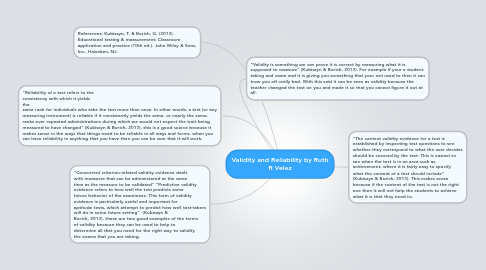Validity and Reliability by Ruth R Velez
by Ruth Velez

1. "Validity is something we can prove it is correct by measuring what it is supposed to measure" (Kubiszyn & Borich, 2013). For example if your a student taking and exam and it is giving you something that your not used to then it can trow you off really bad. With this said it can be seen as validity because the teacher changed the test on you and made it so that you cannot figure it out at all.
2. "Concurrent criterion-related validity evidence deals with measures that can be administered at the same time as the measure to be validated" "Predictive validity evidence refers to how well the test predicts some future behavior of the examinees. This form of validity evidence is particularly useful and important for aptitude tests, which attempt to predict how well test-takers will do in some future setting" (Kubiszyn & Borich, 2013). these are two good examples of the forms of validity because they can be used to help to determine all that you need for the right way to validify the exams that you are taking.
3. "Reliability of a test refers to the consistency with which it yields the same rank for individuals who take the test more than once. In other words, a test (or any measuring instrument) is reliable if it consistently yields the same, or nearly the same, ranks over repeated administrations during which we would not expect the trait being measured to have changed" (Kubiszyn & Borich, 2013). this is a good source because it makes sense in the ways that things need to be reliable in all ways and forms. when you can have reliability in anything that you have then you can be sure that it will work.
4. References: Kubiszyn, T. & Borich, G. (2013). Educational testing & measurement: Classroom application and practice (10th ed.). John Wiley & Sons, Inc., Hoboken, NJ.
5. "The content validity evidence for a test is established by inspecting test questions to see whether they correspond to what the user decides should be covered by the test. This is easiest to see when the test is in an area such as achievement, where it is fairly easy to specify what the content of a test should include" (Kubiszyn & Borich, 2013). This makes sense because if the content of the test is not the right one then it will not help the students to achieve what it is that they need to.


